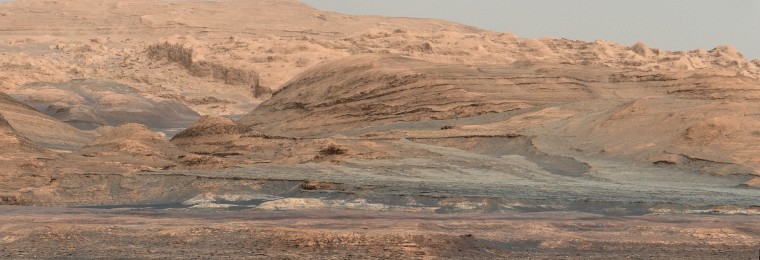John P. Grotzinger, the Fletcher Jones Professor of Geology and chair of the Division of Geological and Planetary Sciences at the California Institute of Technology, will deliver the McDonnell Distinguished Lecture on Wednesday, March 2, at Washington University in St. Louis.
The lecture, titled “A Habitable Environment in the Gale Crater on Mars,” will begin at 7 p.m. in Room 100 of Whitaker Hall on the Danforth Campus. Sponsored by the university’s McDonnell Center for the Space Sciences, the event is free and open to the public.
The Mars Science Laboratory Curiosity touched down in Gale Crater on Mars on Aug. 5, 2012. Within a few days, it began a systematic exploration of the sedimentary rocks that underlie Mt. Sharp, a 16,500-ft. high mound located in the center of the crater.
“We chose (the Gale Crater as a landing site) based on the logic that water flows downhill, and on the evidence for an abundance of hydrated minerals, such as clay and sulfates, there. But the main draw was a 5-km-high stack of sedimentary rocks shaped like Hawaii (Mount Sharp), possibly one of the most significant sedimentary outcroppings in the entire solar system,” Grotzinger told PNAS in a 2011 interview.
On March 12, 2013, Grotzinger and his colleagues announced that Curiosity had discovered an abundance of evidence that Gale Crater was once the site of rivers and a sustained lake. Grotzinger will review these findings of biological viability for the Washington University audience.
Grotzinger, who was the project scientist of the Mars Science Laboratory mission from 2006-2014, apprenticed for the job of searching for life on ancient Mars by searching for life on ancient Earth.

In 1999, he challenged the idea that stromatolites are always formed by sediment-trapping microbial mats and suggested that far back in time, the precipitation of carbonates becomes more important than microbial life to the point that in the earliest rocks on Earth — and potentially in sediments on Mars — the role of biology can be difficult to ascertain. He proposed instead that early stromatolites might be “environmental dipsticks,” sensitive proxies for the changing chemistry of seawater.
In 2003, he made the startling suggestion that the Cambrian Explosion, or sudden appearance of a wide variety of animals about 540 million years ago, had in fact been triggered by an environmental catastrophe that led to the extinction of existing animals. This extinction event, he said, cleared the way for the Cambrian fauna.
In 2007, Grotzinger received the Charles Doolittle Walcott Medal from the National Academy of Science for his contributions to the study of the Precambrian and Cambrian periods in Earth’s history.
The McDonnell Center, established in 1975 through a gift from aerospace pioneer James S. McDonnell, is a consortium of Washington University faculty, research staff and students, primarily from the earth and planetary sciences and physics departments, both in Arts & Sciences. They are working on the cutting edge of space sciences research.
For more information, contact Trecia Stumbaugh at trecia@wustl.edu or 314-935-5332.

Comments and respectful dialogue are encouraged, but content will be moderated. Please, no personal attacks, obscenity or profanity, selling of commercial products, or endorsements of political candidates or positions. We reserve the right to remove any inappropriate comments. We also cannot address individual medical concerns or provide medical advice in this forum.